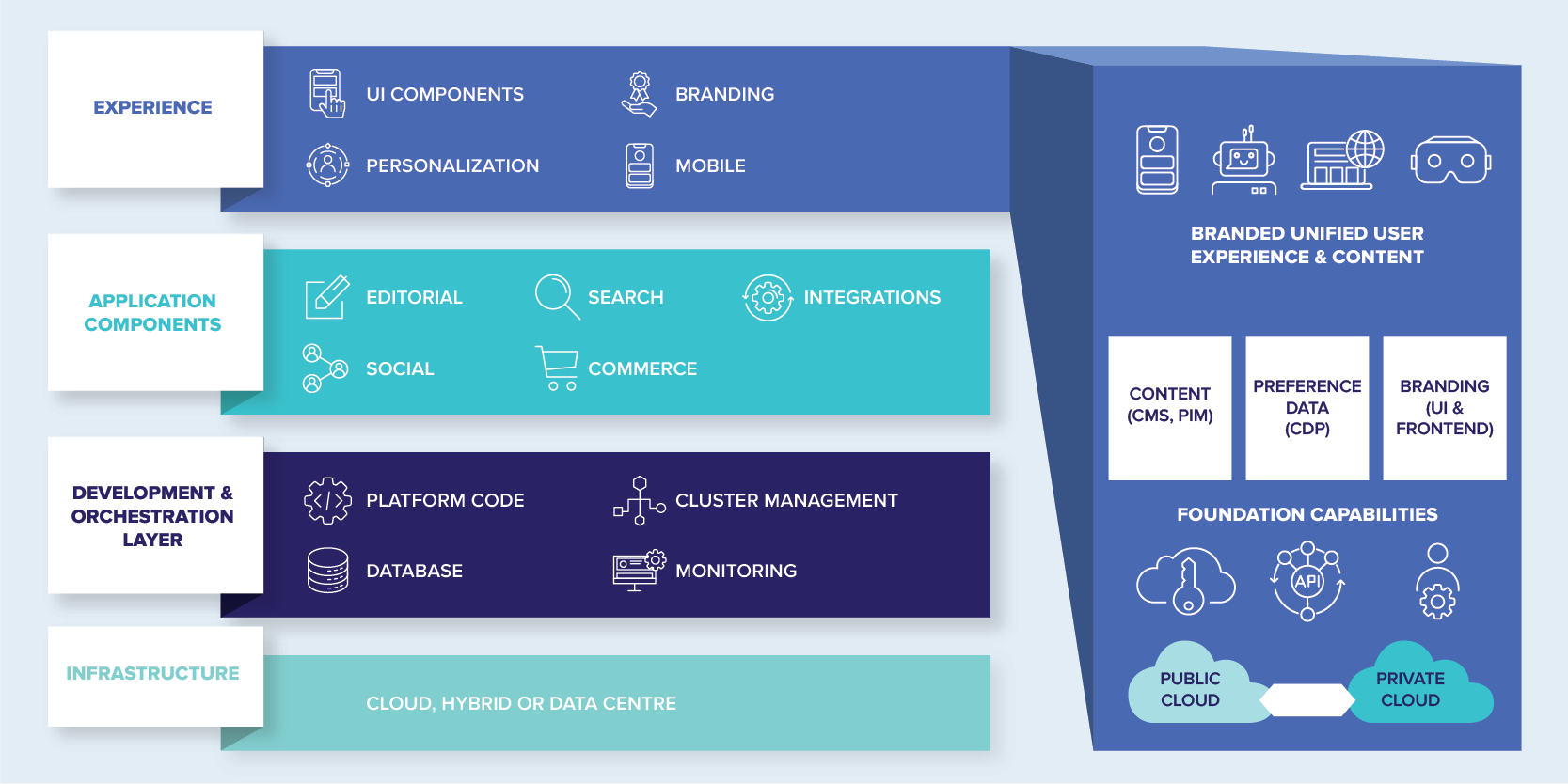Business composability is the mindset, technologies, and set of operating capabilities that enable organizations to innovate and adapt quickly to changing business needs. It is built on applying the key principle of modularity to business assets to achieve the scale and pace required of business ambition. - Gartner
To achieve business agility, organizations need to be nimble and have ‘reassembling capabilities’ to scale in terms of computing power, storage, networks and databases. Various architecture patterns have evolved to address these needs in the form of, ‘multi-cloud portability’, ‘proactive maintenance with observability’ and ‘resilience for always-on business’. Across the industry, this is being achieved by separately addressing the infrastructure layer, application layer, data layer, business logic layer & presentation layer.
The emerging focus on separation of concerns brought together various companies to form the MACH Alliance, where enterprises can quickly adapt & integrate best-of-breed technologies for Microservices-based, API-first, Cloud-native & Headless applications. In this blog, I will focus on how composable architecture helps companies create a flexible and engaging presentation layer that helps businesses gain customers, collect first-party data for personalization & build long-term brand loyalty.
Composable Architecture
Composable architecture is the foundation of orchestrating the infrastructure needs like computing power, storage, networks and databases. Yes, it’s imperative because composable architecture is crucial for businesses of all sizes on account of the 3 forces coming together:
- “Every company is a software company”
Over 80% of companies say Digital Transformation is one of the top strategic goals. In the last decade, the focus has been on the digitalization of business processes & all customer touchpoints. Enterprises have realized Commercial off the shelf (COTS) solutions/all-in-one packaged products don’t have the flexibility, speed-to-market, or integrations that enable them to quickly react to the market changes - a fundamental advantage of Digital Transformation. - Open Source Frameworks are key components of enterprise roadmap
Red Hat’s ‘State of Enterprise Open Source’ report found 90% of IT leaders reported using Open Source in their organizations while 87% see Open Source as more secure for their modernization initiatives than proprietary software. While companies are constructing architectures with “best of the breed” technologies, they want to retain the flexibility to quickly adopt new frameworks without having to rewrite multiple components. - Experience is the competitive differentiator
Gartner’s survey estimates 89% of companies expect to compete largely based on customer experience and this was in 2016. Over the last 5 years Customer experience, usability & recall have only gained more prominence.
Proprietary & monolithic DXPs may be an easier starting point if a brand quickly wants to create online experiences. But they deter your ability to respond swiftly to the changing market demands. Gartner reports that ‘time-consuming integrations and rollouts of monolithic DXPs negatively impact organizational agility and ability to innovate’.
Composability: The Future for Customer Experience
Customer experience solutions have overtaken pricing and product as the key brand differentiator in recent times. Recent statistics show that 86% of users are ready to pay more for a gratifying customer experience management. As customers continue to seek unified experiences across multiple digital devices and channels, businesses cannot turn away from investing in omnichannel experience. The proliferation of digital channels and the need for multiple technology integrations are driving the adoption of digital experience platforms (DXPs).
The retrieve? Switch to composable DXP!
Composable DXP applications are developed as smaller, task-oriented, and independently deployable units, known as packaged business capabilities (PBCs). As defined by Gartner, composable business leverages PBCs that can be assembled and combined meaningfully to respond rapidly to the changing market conditions. If an organization’s DXP architecture is open to integrating third-party solutions, it allows them to improve their platform’s native capabilities. For example, personalization, analytics, and voice search are some of the common integrations today.
Composable DXP strategy enables marketers to tailor web pages and apps without heavily depending on IT teams. Leveraging a centralized content management approach, composable DXPs offer designers and marketers access to reusable templates, components, and content. This empowers brands to stay ahead of the game by adapting to new digital experience platforms even before they hit the market.
A digital experience platform is built on three key components - content management, presentation, and personalization. With application composability, your organization can align to these benchmarks now and in the future.
Benefits of composable DXP
Gartner estimates that by 2023, companies that have embraced composability will outperform their rivals by 80% with respect to the pace of new feature implementation.
The benefits of composable DXP strategy are explicit:
Customizable: Most traditional DXPs prevent users from customizing their solutions due to vendor lock-in, legacy technology, and rigid decomposable architecture. Composable DXPs allow tailoring tech stacks according to your business requirements.
Customer-first: A composable DXP works as a central hub that monitors customer behavior and enables you to personalize content and campaigns for each user. It also allows you to deliver a unified and seamless experience across all customer touchpoints.
Ease of use: Marketers, as well as non-technical users, can modify interfaces and experiences quickly without relying on technical experts.
Faster implementation: Composable DXPs accelerate your cloud-native adoption with shorter implementation cycles and improve your turnaround time.
Third-party integrations: The open architecture of composable DXPs allows your enterprise to integrate powerful tools from multiple vendors. This helps enhance your platform’s native capabilities.
MACH: The ecosystem that powers composable businesses
Businesses are turning to the MACH ecosystem, defined by MACH Alliance, to upgrade their legacy systems and attain composability. MACH offers a set of principal technologies that helps build a composable business by making every component scalable, pluggable, and replaceable.
Microservices based: Offers a collection of loosely-coupled, individual business functionality components that can be developed, deployed, and managed independently.
API-first: Application functionalities are introduced through APIs to facilitate quick connections.
Cloud-native: Allows replacing your on-premise enterprise suites with powerful Software as a Service (SaaS) solutions that leverage the cloud for storage, hosting, elastic scaling, and faster updates.
Headless: Headless or decoupled architecture separates the presentation layer (front-end) from back-end services and logic. It allows users to create, manage, store, and publish content across the web, mobile, and other digital channels from a centralized hub.
Flexible components allow you to implement changes without breaking down the entire application. For example, you don’t have to replace an entire tech stack to update your eCommerce application content that requires frequent updates. Independent microservices, API connectivity, cloud-hosting, and headless decoupling future-proof your enterprise technology and help deliver outstanding digital experiences.
Why is Drupal the best composable digital experience platform?
Drupal’s modular framework offers built-in extensibility via its cloud-based, API-first, low-code, composable architecture. Unlike the conventional monolithic content management systems, Drupal’s modular content components - termed as “nodes” - allow businesses to repurpose content across multiple digital touchpoints.
Drupal ecosystem, with its world-class enterprise content management and integration capabilities, hosting, technical support, and code, is well-armed to take a central position in the composable DXP landscape.
Here’s why businesses are choosing Drupal as their digital hub:

Adaptable and open architecture: Drupal is flexible enough to support coupled, partially decoupled, and fully decoupled architectures. Its core services layer powers any type of integration sought by businesses today. Drupal’s hybrid decoupled model enables developers and marketers equally to make the most of composable experiences.
Ability to extend features: Drupal offers a vast range of contributed modules (contrib) and themes to extend your DXP. The modular nature of Drupal core allows integrating third-party contributed modules and themes without overwriting your customizations or modifying Drupal’s core code. This enables your site administrators to quickly launch new releases with improved flexibility and security.
Structured content management: Fieldable and revisional entities in Drupal provide an advanced system for managing structured content. You can use default entities or create your custom entities to deliver content across different customer touchpoints. Drupal offers a powerful taxonomy core module to organize your website’s content effectively.
Design and layout: Drupal’s layout builder is a core visual tool that enables site builders to enhance the layout and display of their sites. Content creators can organize and present content neatly with minimal effort.
Reusable, low code: Traditional DXPs consume more time for code deployment, even if your site’s change requirement is minor. Drupal’s low-code-based approach shortens your change deployment and release cycles. It offers configuration entities to package and deploy changes securely and reliably. The code configurations can be reused in the future for other applications or websites.
API-first architecture: Drupal is an API-first, free and, open-source CMS that integrates reliably with external tools via secure APIs. It allows you to use your content anywhere and display it as you like. Data managed by Drupal can be made available for any third-party software.
Composable DXP is a must-have for businesses aspiring to create and deliver personalized user experiences. Robust third-party integrations, community support, API-first architecture, low code configurations, experience orchestration, personalization, and presentation capabilities are the top qualities that businesses need to look for while choosing a digital experience platform. These factors prove why Drupal becomes the hot choice for ambitious businesses looking to leverage composability. Up yourself for the game of composability with Drupal. If you’re looking for the right partner to help you with the technical nitty-gritty, talk to us right away.
Our Services
Customer Experience Management
- Content Management
- Marketing Automation
- Mobile Application Development
- Drupal Support and Maintanence
Enterprise Modernization, Platforms & Cloud
- Modernization Strategy
- API Management & Developer Portals
- Hybrid Cloud & Cloud Native Platforms
- Site Reliability Engineering



